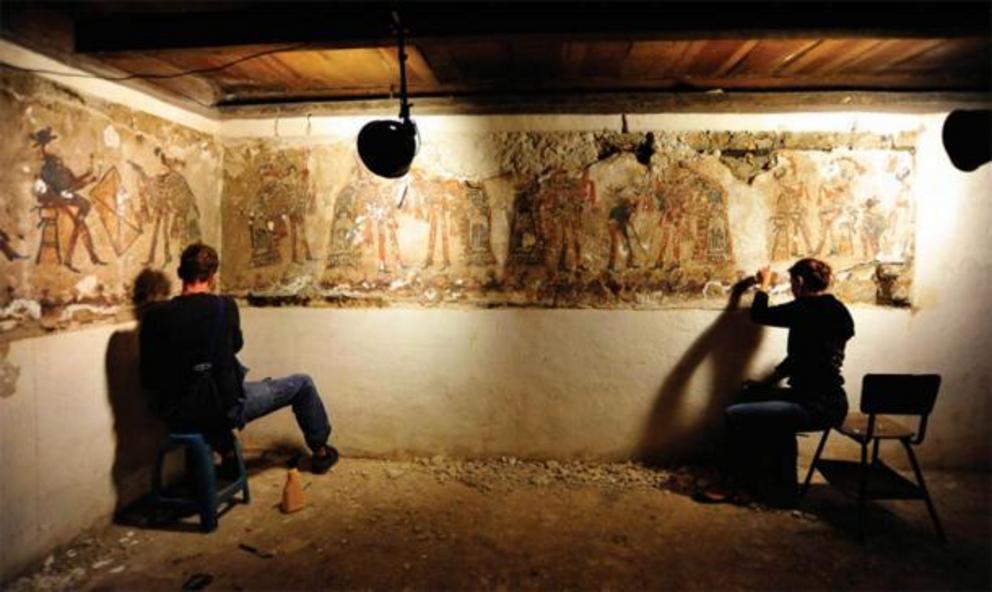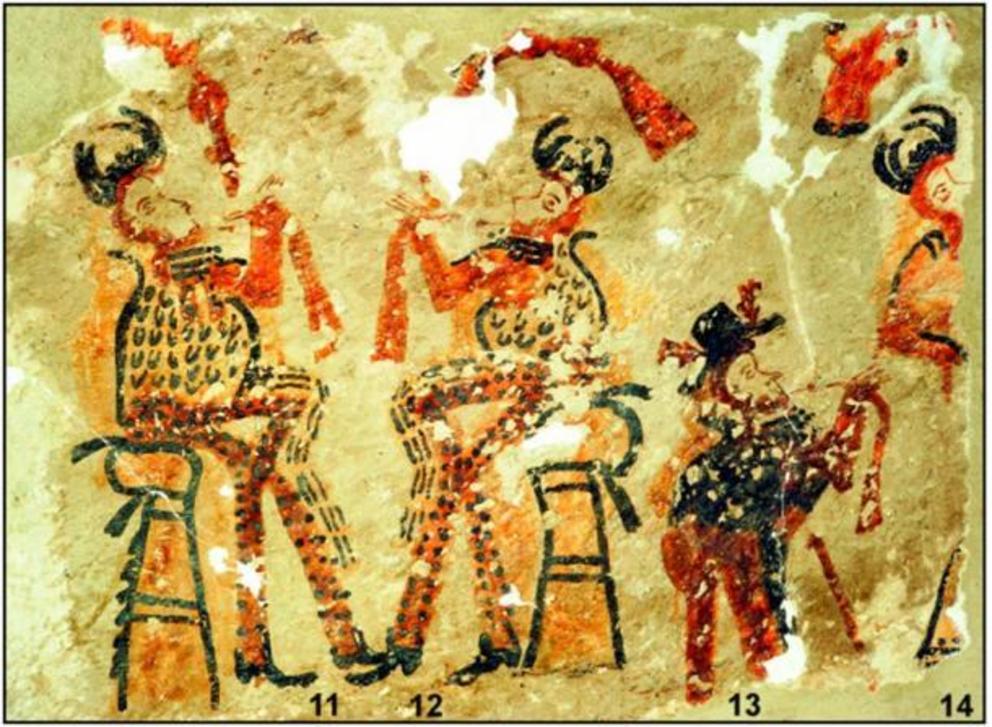Stunning Maya wall paintings uncovered in Guatemalan house
Part of the Maya wall paintings featuring musicians dressed in European attire (three figures on the left) and a dancer in Maya dress (rightmost figure).
Remarkable Maya wall paintings have been found in Guatemala that are unparalleled in Central America . These newly discovered Maya murals are special because they contain both indigenous and Spanish imagery and motifs. These extraordinary murals are helping researchers to better understand the history of the Ixil Maya culture and the Colonial period in the region.
The new Ixil Maya wall paintings were discovered in Chajul in western Guatemala. Chajul was a major center of the Ixil Maya, who still retain many aspects of their traditional culture today despite suffering greatly during the Guatemalan Civil War (1960-1996). According to the study, published in Antiquity, before the arrival of the Spanish conquistadors ‘Chajul was already one of the largest pre-Columbian centres in the region,’ and it is mentioned in the Rabinal Achí, which is based on Ixil Maya court dramas from the Classic period.
The New Maya Wall Paintings Were Found Under Existing Murals
‘The artwork was first discovered by the owner of the house in 2003’ according to an Antiquity press release. There were several layers of paint on the murals and they had been re-painted several times. The wall paintings were studied briefly by researchers, but it was only when a team of Polish experts began to conserve the murals that they were properly evaluated. The Polish experts collaborated with local Ixil-speaking people to understand the murals and their help was crucial.
 Conservation work on the Ixil Maya wall paintings in house #3 in 2015.
Conservation work on the Ixil Maya wall paintings in house #3 in 2015.
The paintings depict dancers and musicians. In an exclusive interview with Ancient Origins, Jaroslaw Źrałka, one of the researchers, stated that ‘Dancing played an important role in Maya culture since pre-Columbian times.’ Maya dance dramas recorded the history and beliefs of the Ixils from ancient times. Jarosław told Ancient Origins that ‘dance was so important to indigenous people that it was also used as a tool of conversion by the first missionaries’ (from Spain).
The New Paintings are a Blend of Maya and Spanish Motifs
Other Maya wall paintings have been uncovered at Chajul but none are as complete as the ones found in this family home. Antiquity reports that the new murals ‘decorate the north, east and west walls of the main, central room’. A painting on the south wall was probably destroyed at some time in the past. Researchers could carbon date the murals but not with any great degree of accuracy. It is estimated that they were painted during the colonial period (1520-1820 AD).
 One new Maya wall painting before and after conservation
One new Maya wall painting before and after conservation
The western wall of the main, central room in the house features a 6 ft long (2 m) painting with two musicians accompanied by a dwarf, who are possibly entertaining a figure with a headdress clothed in a mixture of Indian and Spanish clothing. On the adjacent northern wall section of the room, a number of musicians are depicted on stools playing flutes and drums, dressed in a mix of European and indigenous clothing. Some dancers are also depicted wearing what appear to be jaguar pelts, which were part of indigenous customs.
Unique Wall Paintings of Known and “Lost” Secular Dances
The murals were almost certainly painted by local Ixil painters. The colors and paints (made of natural clay pigments) used by the painters were typical of Maya art , and the painting methods and style of the figures do not indicate any special foreign influences, according to Katarzyna Radnicka, one of the researchers, who spoke about the paintings in an interview with Ancient Origins. She also stated in the interview that the ‘black dots placed on an orange background’ in the murals are characteristic of local Maya art. Interestingly the local indigenous people continue to paint in this traditional style.
 Black dots on an orange background are characteristic of local Maya art.
Black dots on an orange background are characteristic of local Maya art.
According to Jaroslaw, what was remarkable about the Chajul murals is that they are secular and in a domestic setting unlike other paintings that ‘mostly concentrated on Christian religious themes and in most cases appear in churches and convents’. With the help of the local Ixil people, the team came to believe that the wall paintings depict dances, possibly the ‘Baile de la Conquista (Dance of the Conquest), or the Baile de Los Moros y Cristianos (Dance of the Moors and Christians),’ according to the Antiquity press statement. The Dance of the Moors and Christians was introduced by the Spanish and the other dance tells the story of the conquest of the Ixil by the conquistadors. The researchers wrote that the murals may represent a dance that was lost after ‘the government-enforced prohibition on the performance of many indigenous dances’ in the 19th and 20th century.
 3D model of the house with the murals highlighted
3D model of the house with the murals highlighted
Mural Room Likely Used for Cofradías’ Fraternity Rituals
The fact that the paintings were found in a domestic space may indicate aspects of their origin and function. The house has been owned by the Asicona family for generations and they believe that the rooms with the painting were used to receive guests in the past. Monika Banach told Ancient Origins that ‘One of the interpretations that we considered is that the owners of the house belonged to the religious brotherhoods and sisterhoods known in Spanish as Cofradías’.
These fraternities were introduced by the Spanish and are still common in Central America, including Chajul. However, many of their members were killed during the Guatemalan civil war when the army launched a genocidal campaign against the Ixils. These associations revered Catholic saints but they also adopted many of the ancestral traditions of the local Maya. According to the present owners of the house, some of their family members joined the religious fraternities and it appears that the rooms with the murals were used by Cofradías for meetings and rituals. The paintings show that the Ixil create a syncretic series of beliefs and cultural practices during the Colonial period, illustrated in the mixture of European and indigenous styles of the murals.
The New Wall Paintings May Show Maya Cultural Resistance
According to the Antiquity report, these unique Maya wall paintings provide us with new insights into the region, and ‘As such, it may reflect the waning control of the Spanish administration, and revitalization of Maya culture’. Moreover, Monika told Ancient Origins that they may illustrate ‘how the Ixil Maya people resisted and negotiated the culture, religion, and values imposed by Spanish invasion/colonialism ’. The researchers hope that other house murals in Chajul may help them to better understand the region in the colonial past and later.

